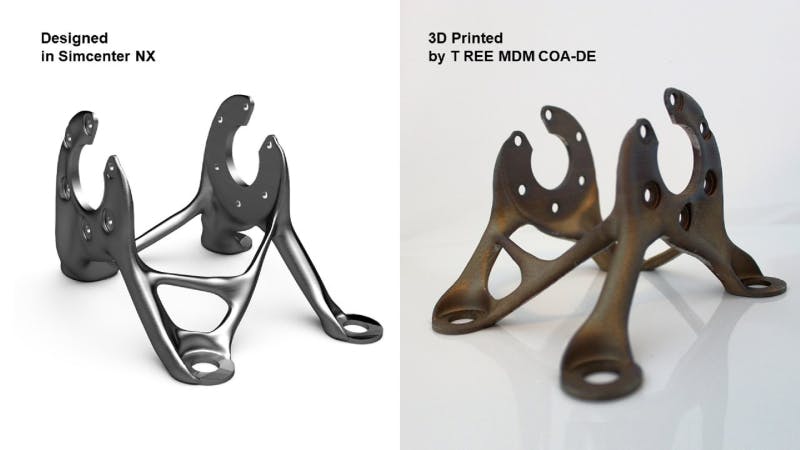Der Einsatz von additiv gefertigten Teilen ermöglicht die Produktion von immer komplexeren Konstruktionen und eine verteilte Fertigung. Doch die Vorhersage der Ermüdungsleistung von additiv gefertigten Teilen ist schwierig. Der Fertigungsprozess bringt eine Vielzahl lokaler Einflussfaktoren mit sich, die sich nicht trennen lassen. Daher kann eine mathematische Modellierung die Interaktion und die Auswirkungen dieser Faktoren nicht beschreiben. Aus diesem Grund ist es heute zu aufwändig, die Ermüdungsbeständigkeit von 3D-gedruckten sicherheitskritischen Bauteilen zu berechnen.
Registrieren Sie sich jetzt für unser On-Demand-Webinar und erfahren Sie, wie Siemens Simcenter 3D Ihnen helfen kann:
- Integration von Materialmodellen mit maschinellem Lernen in die offene Umgebung von Bestandsfestigkeits-Solvern
- Berücksichtigung verschiedener durch den AM-Prozess bedingter Faktoren, welche die Ermüdung beeinflussen
- Anwendung auf sicherheitskritische Strukturbauteile
Bewältigung der Herausforderungen der Materialermüdung bei additiv gefertigten Teilen
Der herkömmliche Umgang mit Materialermüdung funktioniert bei additiv gefertigten Bauteilen nicht. Es ist unmöglich, die unendliche Kombination von Materialbedingungen und Ermüdungseinflussfaktoren zu testen oder sie zu trennen und ihre Wechselwirkung und isolierte Wirkung zu beschreiben. Auch ist eine Datenbank nicht hilfreich, und keine Formel kann SN-Kurven für einen zufälligen Satz von Materialbedingungen vorhersagen. Um das Problem der Ermüdung von AM-Bauteilen zu lösen, müssen die Ingenieure den Prozess mit dem Material und der Bauteilleistung in Verbindung bringen, was ein Werkzeug erfordert, das die Ermüdungsleistung für jede beliebige AM-Bedingung aufzeigen kann.
Einsatz von maschinellem Lernen zur genaueren Modellierung der Ermüdungsleistung von AM-Komponenten
Ingenieure können es sich zeitlich nicht erlauben, jede Bedingung des additiven Fertigungsprozesses zu testen, und selbst wenn sie es könnten, lassen sich einige unmöglich in einer Couponskala berücksichtigen. Die Lösung für die genaue Modellierung der Ermüdungsleistung von AM-Komponenten ist eine Datenbank für maschinelles Lernen (ML). Das ML-Modell lernt, wie sich die einzelnen Parameter auf die Lebensdauer auswirken, um die Ermüdungslebensdauer für alle die Ermüdung beeinflussenden Faktoren vorherzusagen. Wenn die Tests begrenzt sind, wird das ML-Modell aus den wenigen verfügbaren Daten immer noch eine „bestmögliche Einschätzung" anstellen, während andere Methoden unzureichende Ergebnisse liefern werden. Schließlich können verschiedene Eingaben kombiniert werden, um den Datensatz anzureichern und ein einziges ML-Modell aus Vorwissen, eigenen Tests, Finite-Elemente-Simulationen (FE), empirischen Regeln aus der Literatur oder Erfahrung zu erstellen.
Integration von Lebensdauerberechnungen zur genauen Vorhersage der Ermüdung von AM-Komponenten
Ingenieure können mithilfe von Lebensdauerberechnungen die Ermüdungslebensdauer vorhersagen und die Konstruktion anpassen, um eine sichere Verwendung des Bauteils zu gewährleisten. Die Ingenieure müssen jedoch ihre Bestandsfestigkeits-Solver so anpassen, dass sie die lokalen Ermüdungseigenschaften von AM-Komponenten berücksichtigen können. Die Simcenter 3D-Lösung ist ein einzigartiger Bestandsfestigkeits-Solver, der die durch den AM-Prozess bedingten lokalen Eigenschaften bei der Lebensdauerberechnung von Bauteilen berücksichtigt. Die Integration der AM-spezifischen Lebensdauerberechnung ermöglicht eine genaue Ermüdungsvorhersage unter Berücksichtigung von prozessbedingten lokalen Ermüdungseinflussfaktoren und Nachbearbeitungsmaßnahmen. Sie kann die Auswirkungen von Defekten bewerten und dort, wo es erforderlich ist, eine hohe Druckqualität sicherstellen, um die Gesamtproduktivität zu erhöhen, ohne die Sicherheit der gedruckten Teile zu beeinträchtigen, und gleichzeitig die Zertifizierung von 3D-gedruckten Komponenten unterstützen.
Sehen Sie sich das On-Demand-Webinar an, um zu erfahren, wo herkömmliche Methoden versagen, und um den korrekten Versagenszeitpunkt und die Ermüdungsbeständigkeit von 3D-gedruckten Teilen genau vorherzusagen.
Vorstellung der Referenten

Dr. Michael Hack
Managing Simcenter Durability Simulation Solutions
Michael Hack ist seit 25 Jahren bei Siemens in verschiedenen Positionen tätig. In seiner derzeitigen Position als Product Line Manager für Lebensdauersimulationen verbindet er Kundenbedürfnisse mit akademischer Forschung und hat zahlreiche Forschungsprojekte zu Hystereseoperatoren, Rainflow Counting, thermischer Ermüdung, Verbundwerkstoffermüdung sowie Zuverlässigkeits- und Optimierungsthemen vorgestellt und veröffentlicht.

Dr. Hunor Erdelyi
CAE 3D Senior Research Engineer
Hunor Erdelyi ist seit mehr als zehn Jahren bei Siemens Digital Industries Software in verschiedenen Forschungs- und Entwicklungsfunktionen tätig. Derzeit ist er Senior Manager im CAE 3D R&D Team und konzentriert sich in dieser Funktion auf Lösungen für neue Materialien und additive Fertigung (Additive Manufacturing, AM). Hunor und sein Team helfen den Kunden bei der Simulation von AM-Prozessen, der Vorhersage der daraus resultierenden Mikrostrukturen, Defekte und der damit verbundenen Materialeigenschaften sowie deren Auswirkungen auf die Leistungsfähigkeit der Teile, wie z. B. Festigkeit und Lebensdauer.
